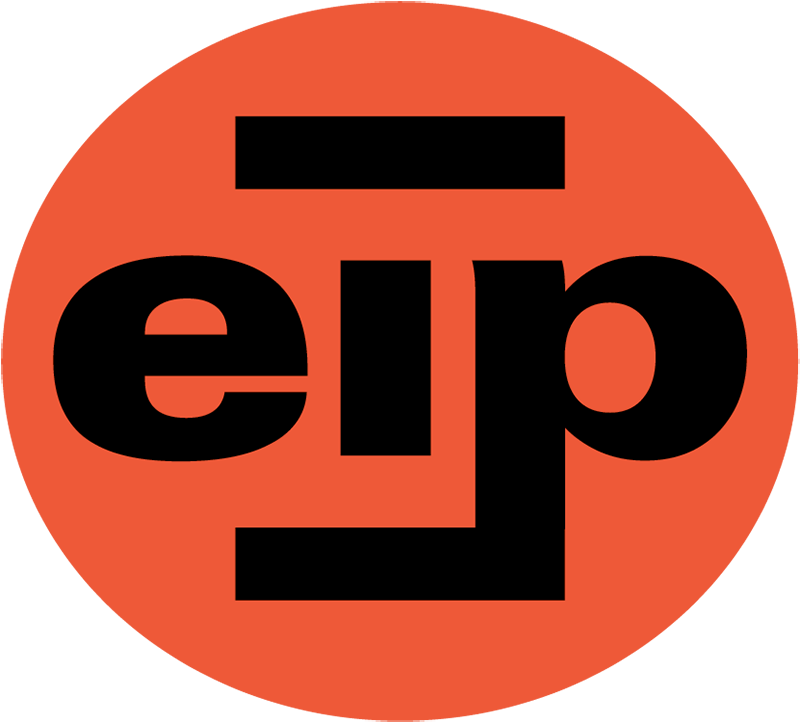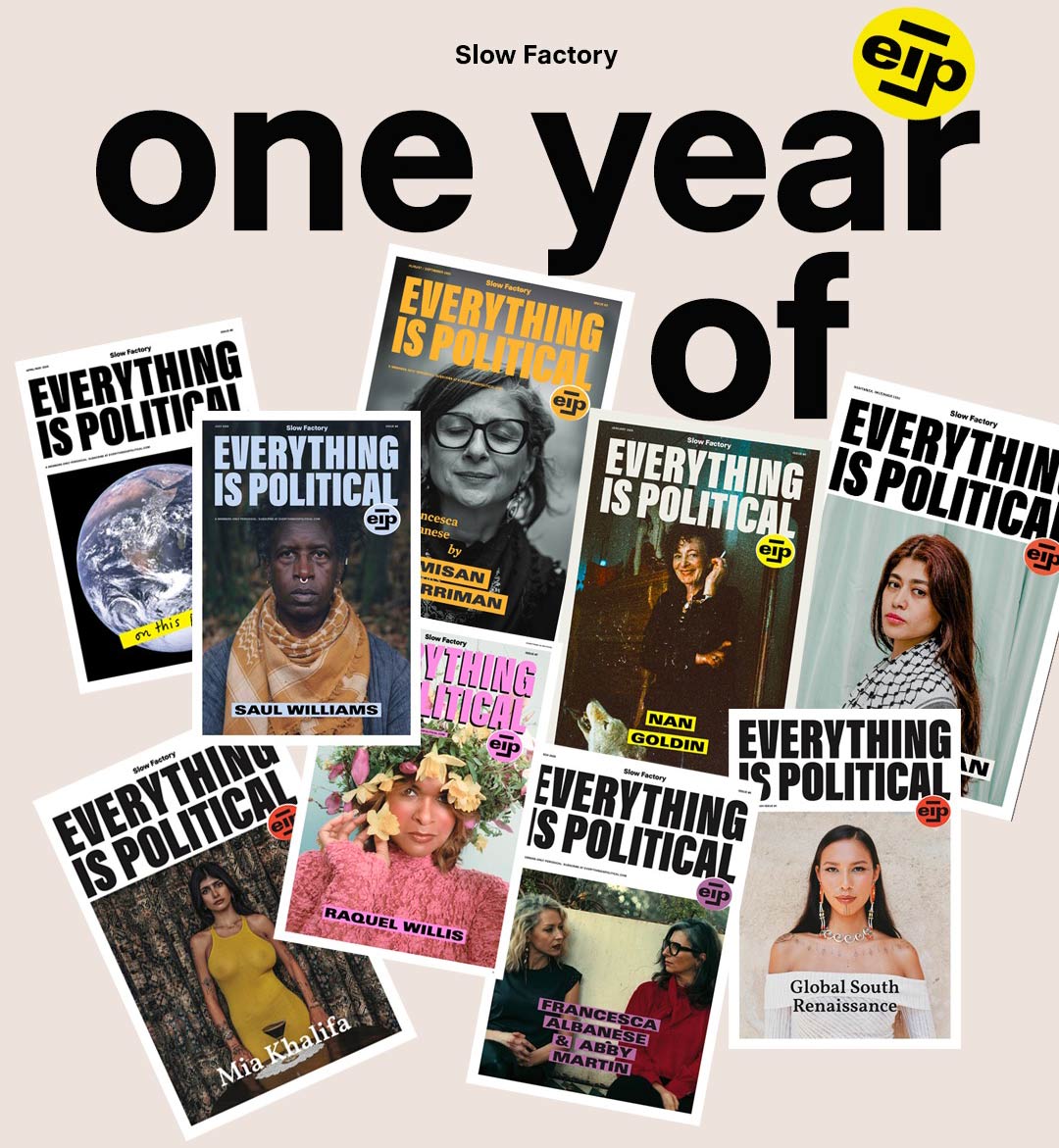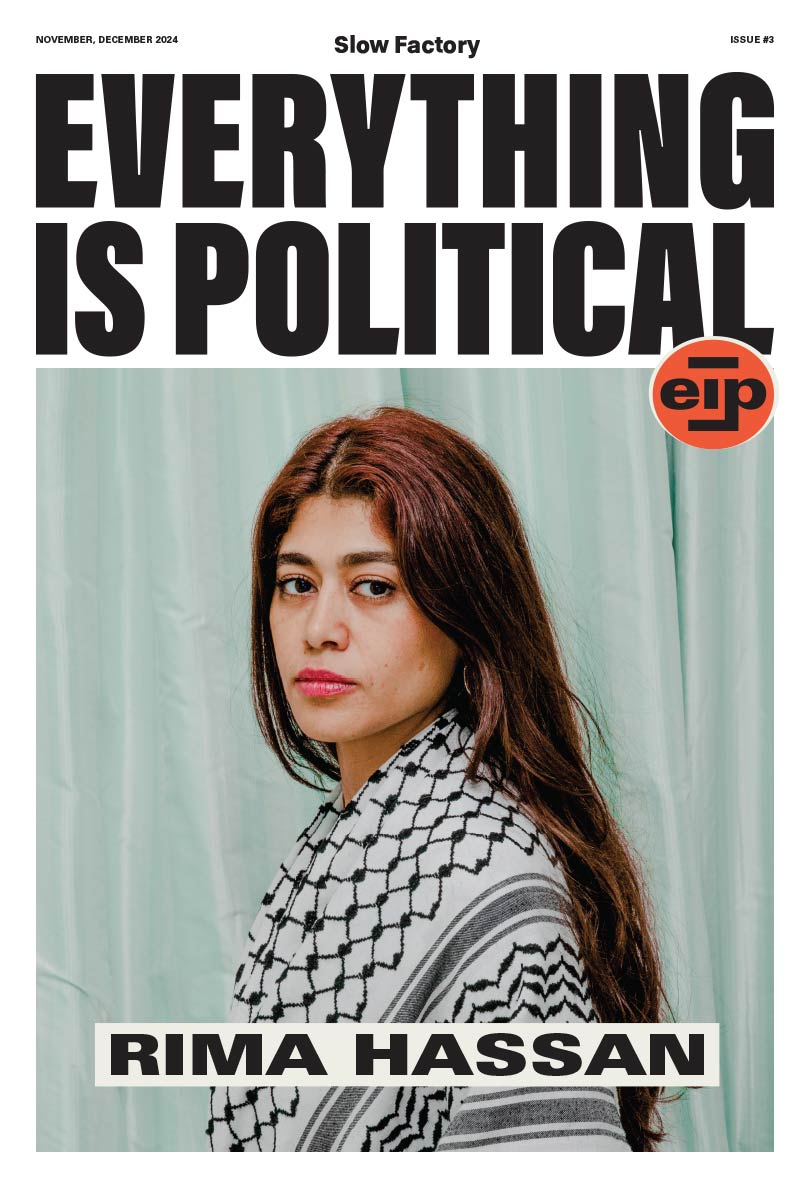Digital & Print Membership
Yearly + Receive 8 free printed back issues
$420 Annually
Monthly + Receive 3 free printed back issues
$40 Monthly
Reclaiming Language
Marwan Kaabour’s Queer Arab Glossary & the Power of Words
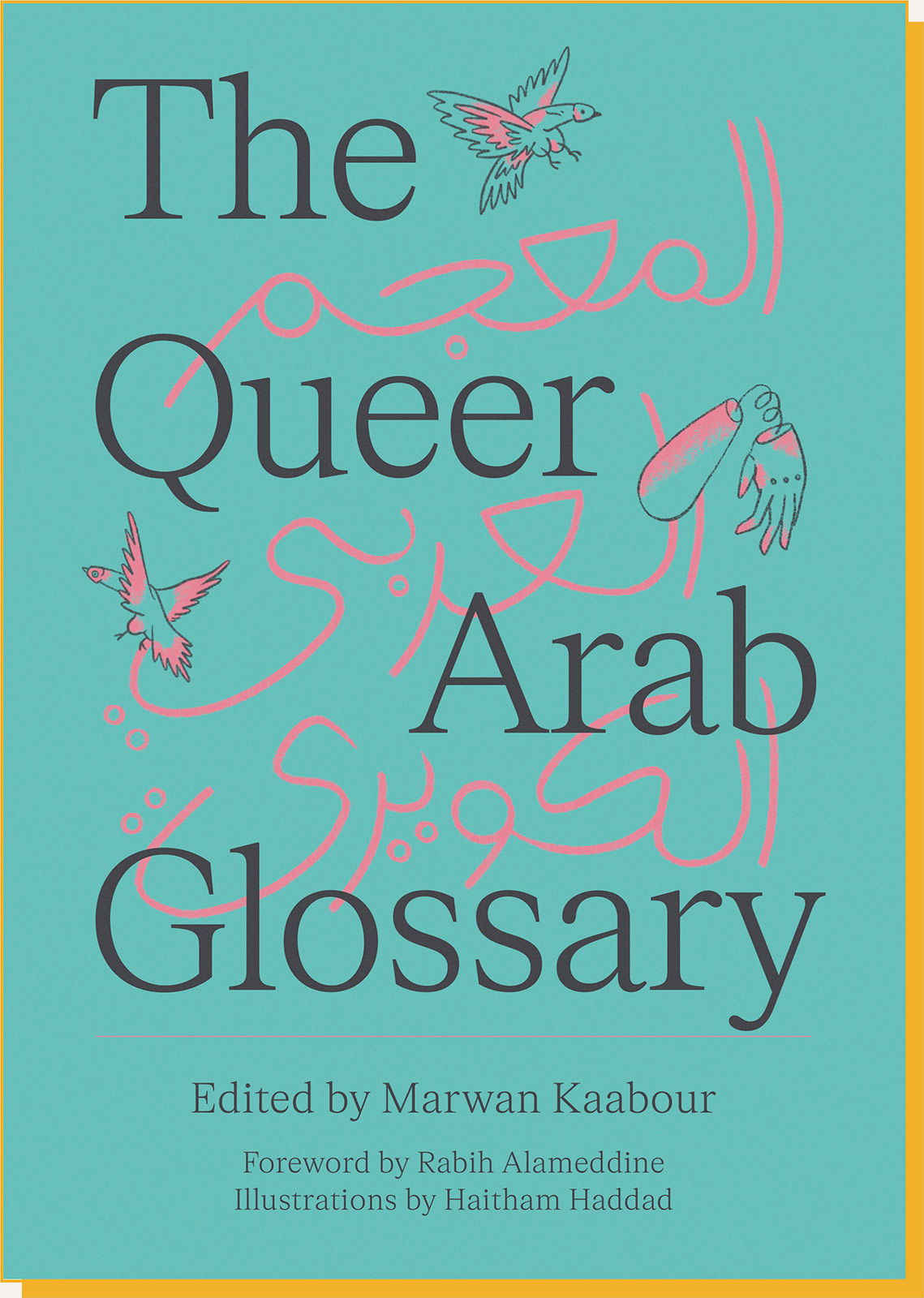
AFEEF: Using your own glossary, which phrase describes you best? Aka how do you identify?
MARWAN: It would be unfair of me to choose only one, so I’m going to go with a couple. I identify as a ṭubjī, which is used in Lebanese dialect in the same way as faggot. Ṭubjī comes from Turkish Ottoman and refers to the person whose job is to operate a cannon. I also identify as Shawwaya, which is Arab for grill rack, and is used in Moroccan and Tunisian to refer to a gay man who is versatile, because just like meat on a grill rack, you’d need to flip him over every now and then!
AFEEF: Other than the phrase you identify with, what were other favorites that you learned in the process?
MARWAN: I love all the words that refer to water, like sāyiţ (Palestinian; watered down); qāyiso-l-mā’ (Morrocan; has been touched by water); māyi‘ (Kuwaiti; liquid); markhūf (Tunisian; loose or swaying); amongst a few others. These words are itended to belittle men who are effiminate or gay, by highlighting the way they sway while walking, or the fact that they have “limp wrists”. Despite the derogotary connotation, I find the use of water as a metaphor to refer to queer people as deeply poetic and beautiful. Just like water, queerness is a limitless, boundless, ever-changing and morphing thing.
AFEEF: Why is documenting queerness in the Arabic speaking world important to you?
MARWAN: Understanding one’s own history, whether on a micro personal scale or a macro national/international scale, allows one to learn and grow. Otherwise we end up getting stuck in versions of the truths that lack much needed context and nuance. As a queer Arab person, I found it difficult to find accessible records and literature that I saw myself in. As someone with experience and skill in storytelling and visual communication, I decided to take matters into my own hands. So I started Takweer [Kaabour’s online platform], and that allows me to better understand myself and how queer Arabs are situated across our own history. It also allows the queer Arab community to engage with the project, which contributes to community-building and re-enforcing the bonds that exist between our sense of queerness and Arabness. I also hope it adds much needed complexity to the dominant eurocentric notion of queerness.
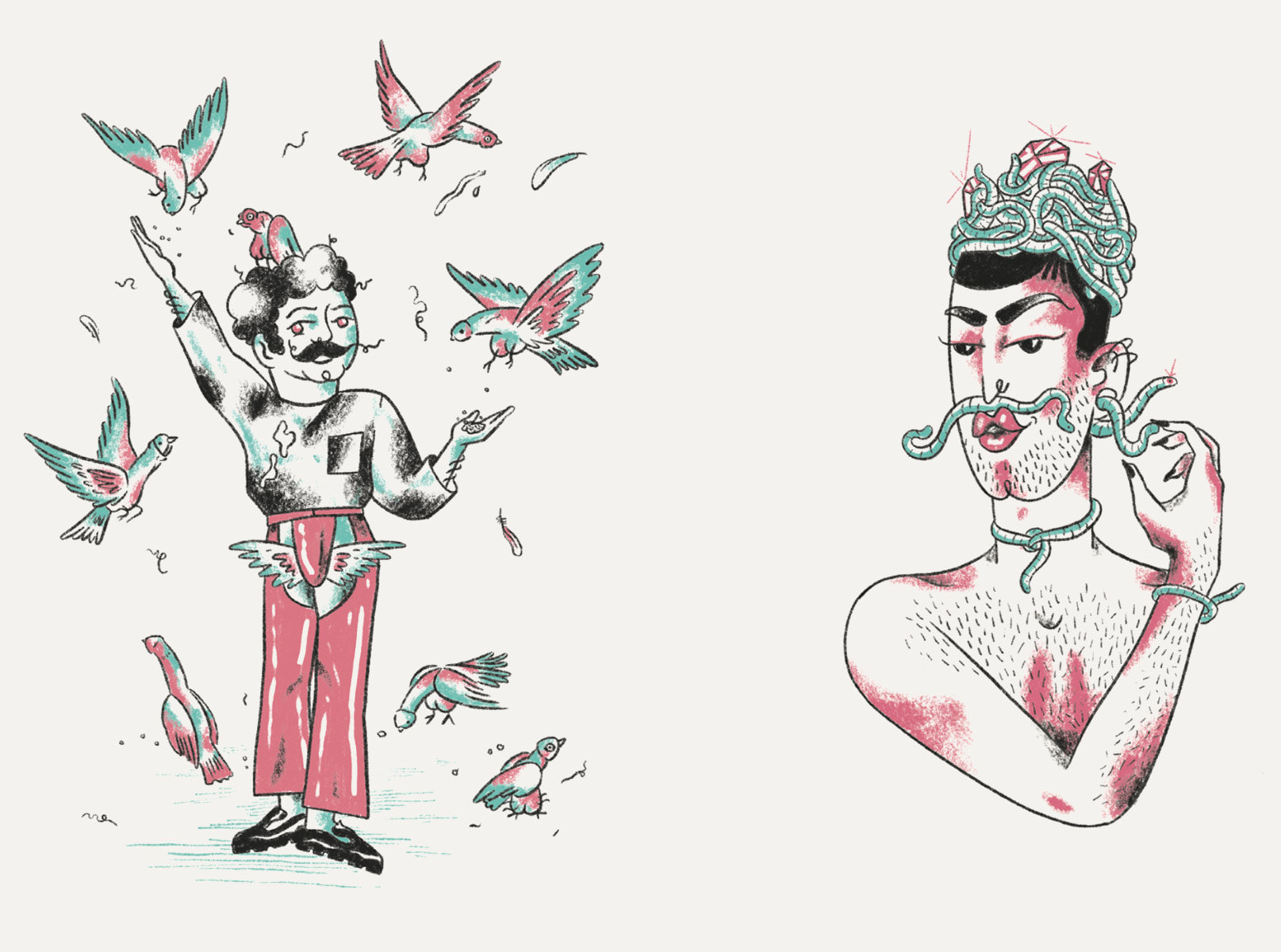
AFEEF: What gave you the idea for this book?
MARWAN: Takweer is an Instagram page I created that serves as an ever-expanding archive of queer narratives in Arab history and pop culture. The knowledge that I accumulate in my research and the exchanges I have with the page’s followers also serve as a space for new ideas to develop and be fully realized. I would often come across queer Arabic slang during my research, or would spot it in the comments or in the DMs by Arabic-speakers who spoke different dialects from my own. Generally speaking, I have always been interested in language and the multifaceted nature of language and meaning, so I started to develop a curiosity exploring the entire linguistic landscape surrounding queerness in the Arabic-speaking region. In the spring of 2020 I put a call-out on Takweer, asking the page’s followers to submit words and terms used to identify someone who is queer (or perceived as queer). I expected a few dozen responses, but I ended up compiling a few hundred entries insead. That’s when I knew I needed to dedicate more time to develop this project properly.
AFEEF: What was the methodology? How did you make this thing come together?
MARWAN: The project was collaborative and participatory at every stage. The research process was in three phases: The submissions phase, whereby Takweer followers (and others who were made aware of the call-out) would submit words and terms they are familiar with in their own dialect. I then collated and categorized the submissions across an extensive spread sheet. This was followed by the interview phase, where I would have one-on-one interviews via Zoom or in-person with a group of people from of the Arabic-speaking countries. The interviewees varied in age, socioeconomic class, locality and in the way they identified across the queer spectrum. I would go through the list of the collated entries with each person and discuss its use, familiarity, meaning, etc. Each interview would inform the descriptions as it would either confirm, negate or add to the existing text, and by doing so adding additional context and nuance. Finally, in the editing phase, I invited Suneela Mubayi to come on board as the glossary’s editor. Suneela’s incredible knowledge of the Arabic language and queer histories allowed her to add much-needed historical, linguistic and cultural context to each entry.
It was important for the methodology to be organic and participatory to best reflect the fluid nature of the subject matter: dialect and queerness. There are several examples of existing slang glossaries and queer slang glossaries, but to my knowledge this is the first project to use such a methodology.
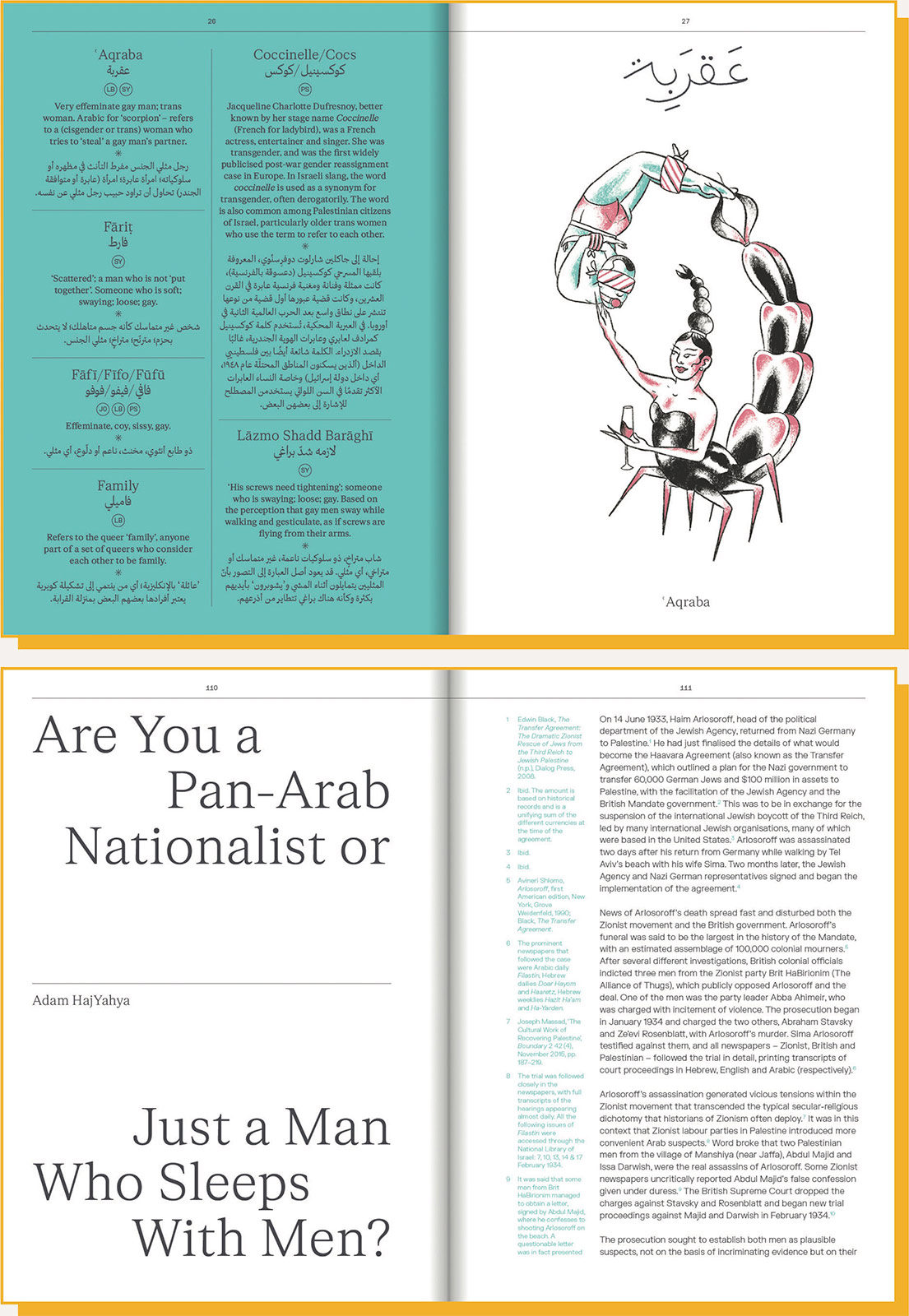
AFEEF: Tell me about the illustrations and what role they serve?
MARWAN: As soon as I decided on creating a printed glossary, I knew I wanted it to be illustrated, just like the old glossaries I used to come across as a child. It’s one thing to illustrate a bird species or a chair, but it’s another to visualize abstract concepts like a Dudaki (Iraqi dialect; wormy one; derogatory term to refer to gay people) or a Nagafa (Egyptian dialect; chandelier; refers to a flamboyant and/or effeminate man). That gave us the chance to imagine these queer characters, who are joyful and at ease with their sense of queerness. I immediately thought of Haitham Haddad’s brilliant skill in creating beautifully complex and relatable characters in his art. The brilliant illustrations Haitham produced allowed us to populate the queer Arab imaginary with these wonderfully eclectic characters that can open up the space for us to dream.
AFEEF: What compelled you to include essays?
MARWAN: An earlier iteration of the project was just an illustrated glossary. When I started exploring the idea of publishing it as a book, I wanted the findings of the glossary to be expanded on and given more dimensionality. I also wanted to open up the space for additional voices from across the Arabic- speaking region, and whose perspectives and experiences are different to mine. The glossary is a record of the lexicon surrounding our queerness, and the essays provide us tools to think through the themes that the glossary explores: queerness, dialect, Arab identity, language, etc. and each essay does that in a uniquely thought-provoking way.
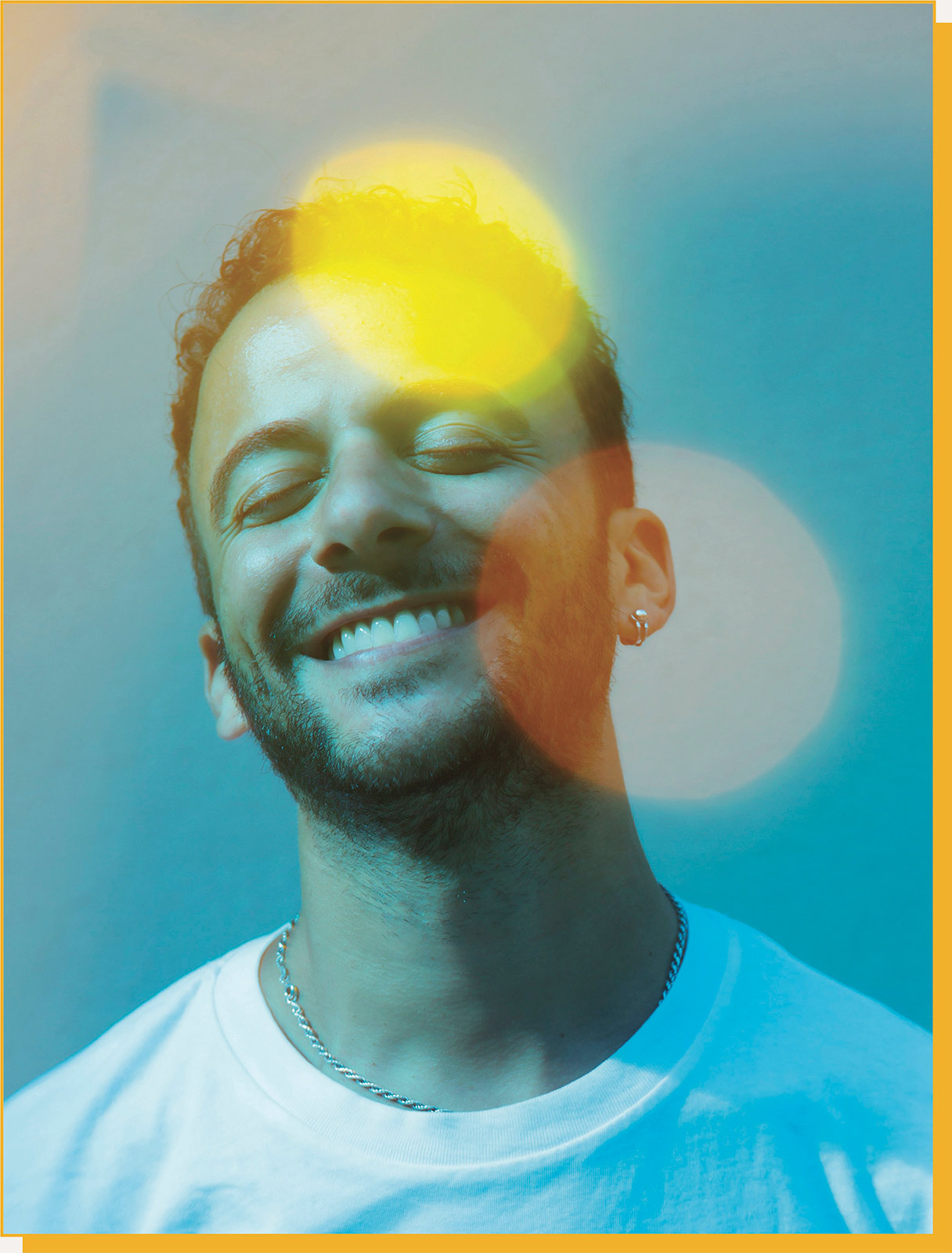
AFEEF: What do you hope people take away from this work?
MARWAN: I hope queer Arabs are able to take pride and learn from a project that centers their experience and humanity at its core. I hope queers in general get to widen their perspectives on a non-eurocentric experience. I hope the general Arab public gets to see queer people as an inseparable part of the fabric of Arab communities, and not some kind of foreign import. I hope Westerners who claim to care about Arabs are able to see how queer and Arab identities have co-existed since the dawn of time, and despite our challenges, we are proud of being Arab. I hope linguists learn from the creativity and wit of queer Arab slang. And I hope for the world to see our humanity, with all of its facets and contradictions, in the face of the zionist death machine that wants to annihilate us.
AFEEF: What have you taken away from this work?
MARWAN: I learnt that nothing is singular. Whether its queerness, language, gender, slang, Arab, etc. these are all notions that encapsulate a multitude of meanings, interpretations, contradictions and experiences. Attempting to overly define or limit any of them would ultimately lead to their demise. Accepting these multiplicities, and allowing for things to change and constantly morph is what keeps life exciting and rewarding.
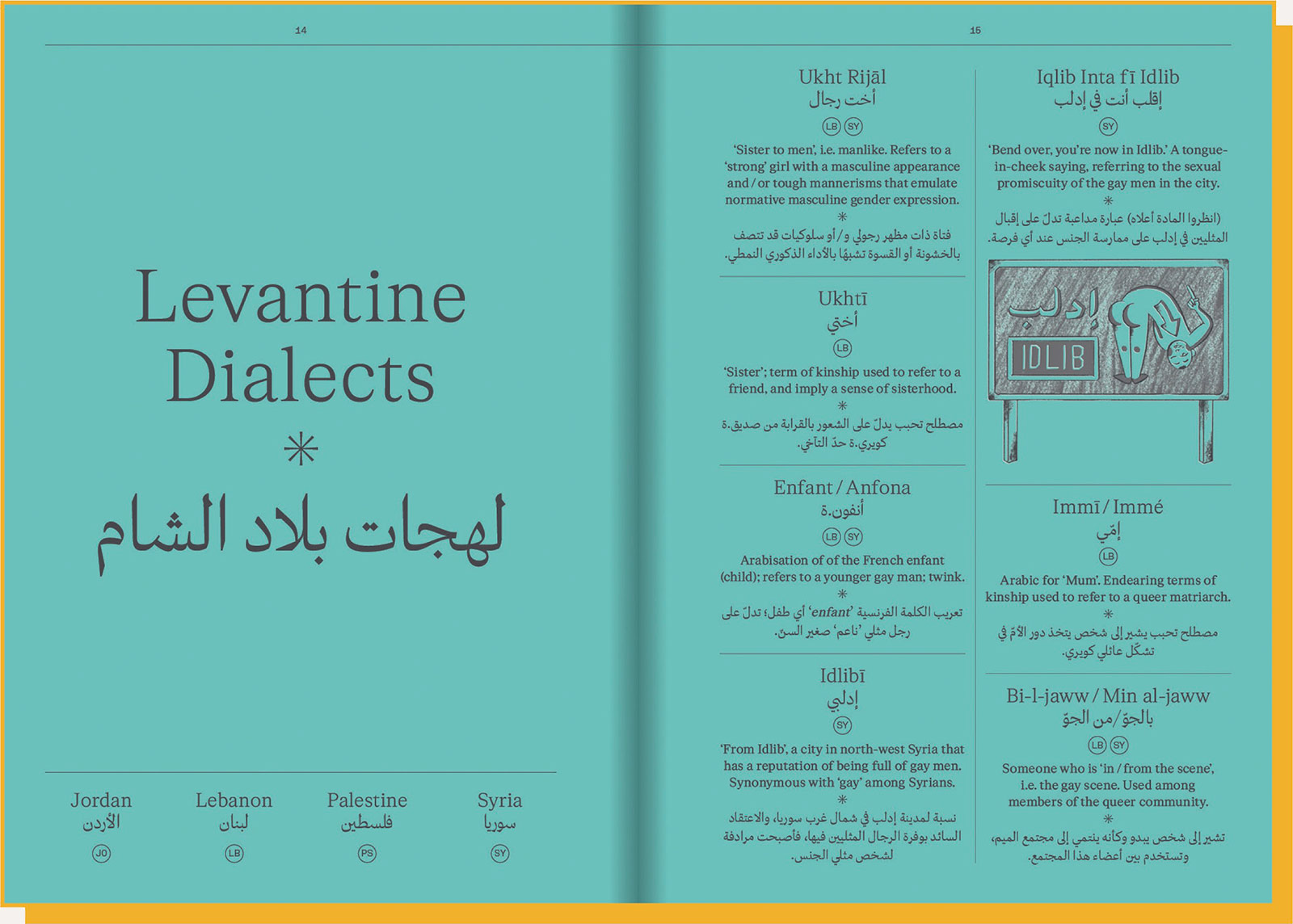
Marwans Kaabour’s “Queer Arab Glossary” is a first-of-its-kind survey of the language used around queerness in the Arab world, bringing together more than 300 words and terms used to refer to queer people across the spoken Arabic dialects. It also includes essays by eight leading Arab queer artists, academics, activists and writers, which situate the glossary in a modern social and political context. The book has beautiful, witty illustrations that make the journalistic masterpiece come to life. Marwan sat with EIP to explain how the Queer Arab Glossary is a powerful response to the myths about queer people in the Arab world.
Topics:
Filed under:
Location:
{
"article":
{
"title" : "Reclaiming Language: Marwan Kaabour’s Queer Arab Glossary & the Power of Words",
"author" : "Marwan Kaabour, Afeef Nessouli",
"category" : "interviews",
"url" : "https://everythingispolitical.com/readings/marwan-kaabour-queer-arab-glossary",
"date" : "2024-12-11 14:33:00 -0500",
"img" : "https://everythingispolitical.com/uploads/marwan-kaabour-4.jpg",
"excerpt" : "",
"content" : "AFEEF: Using your own glossary, which phrase describes you best? Aka how do you identify?MARWAN: It would be unfair of me to choose only one, so I’m going to go with a couple. I identify as a ṭubjī, which is used in Lebanese dialect in the same way as faggot. Ṭubjī comes from Turkish Ottoman and refers to the person whose job is to operate a cannon. I also identify as Shawwaya, which is Arab for grill rack, and is used in Moroccan and Tunisian to refer to a gay man who is versatile, because just like meat on a grill rack, you’d need to flip him over every now and then!AFEEF: Other than the phrase you identify with, what were other favorites that you learned in the process?MARWAN: I love all the words that refer to water, like sāyiţ (Palestinian; watered down); qāyiso-l-mā’ (Morrocan; has been touched by water); māyi‘ (Kuwaiti; liquid); markhūf (Tunisian; loose or swaying); amongst a few others. These words are itended to belittle men who are effiminate or gay, by highlighting the way they sway while walking, or the fact that they have “limp wrists”. Despite the derogotary connotation, I find the use of water as a metaphor to refer to queer people as deeply poetic and beautiful. Just like water, queerness is a limitless, boundless, ever-changing and morphing thing.AFEEF: Why is documenting queerness in the Arabic speaking world important to you?MARWAN: Understanding one’s own history, whether on a micro personal scale or a macro national/international scale, allows one to learn and grow. Otherwise we end up getting stuck in versions of the truths that lack much needed context and nuance. As a queer Arab person, I found it difficult to find accessible records and literature that I saw myself in. As someone with experience and skill in storytelling and visual communication, I decided to take matters into my own hands. So I started Takweer [Kaabour’s online platform], and that allows me to better understand myself and how queer Arabs are situated across our own history. It also allows the queer Arab community to engage with the project, which contributes to community-building and re-enforcing the bonds that exist between our sense of queerness and Arabness. I also hope it adds much needed complexity to the dominant eurocentric notion of queerness.AFEEF: What gave you the idea for this book?MARWAN: Takweer is an Instagram page I created that serves as an ever-expanding archive of queer narratives in Arab history and pop culture. The knowledge that I accumulate in my research and the exchanges I have with the page’s followers also serve as a space for new ideas to develop and be fully realized. I would often come across queer Arabic slang during my research, or would spot it in the comments or in the DMs by Arabic-speakers who spoke different dialects from my own. Generally speaking, I have always been interested in language and the multifaceted nature of language and meaning, so I started to develop a curiosity exploring the entire linguistic landscape surrounding queerness in the Arabic-speaking region. In the spring of 2020 I put a call-out on Takweer, asking the page’s followers to submit words and terms used to identify someone who is queer (or perceived as queer). I expected a few dozen responses, but I ended up compiling a few hundred entries insead. That’s when I knew I needed to dedicate more time to develop this project properly.AFEEF: What was the methodology? How did you make this thing come together?MARWAN: The project was collaborative and participatory at every stage. The research process was in three phases: The submissions phase, whereby Takweer followers (and others who were made aware of the call-out) would submit words and terms they are familiar with in their own dialect. I then collated and categorized the submissions across an extensive spread sheet. This was followed by the interview phase, where I would have one-on-one interviews via Zoom or in-person with a group of people from of the Arabic-speaking countries. The interviewees varied in age, socioeconomic class, locality and in the way they identified across the queer spectrum. I would go through the list of the collated entries with each person and discuss its use, familiarity, meaning, etc. Each interview would inform the descriptions as it would either confirm, negate or add to the existing text, and by doing so adding additional context and nuance. Finally, in the editing phase, I invited Suneela Mubayi to come on board as the glossary’s editor. Suneela’s incredible knowledge of the Arabic language and queer histories allowed her to add much-needed historical, linguistic and cultural context to each entry.It was important for the methodology to be organic and participatory to best reflect the fluid nature of the subject matter: dialect and queerness. There are several examples of existing slang glossaries and queer slang glossaries, but to my knowledge this is the first project to use such a methodology.AFEEF: Tell me about the illustrations and what role they serve?MARWAN: As soon as I decided on creating a printed glossary, I knew I wanted it to be illustrated, just like the old glossaries I used to come across as a child. It’s one thing to illustrate a bird species or a chair, but it’s another to visualize abstract concepts like a Dudaki (Iraqi dialect; wormy one; derogatory term to refer to gay people) or a Nagafa (Egyptian dialect; chandelier; refers to a flamboyant and/or effeminate man). That gave us the chance to imagine these queer characters, who are joyful and at ease with their sense of queerness. I immediately thought of Haitham Haddad’s brilliant skill in creating beautifully complex and relatable characters in his art. The brilliant illustrations Haitham produced allowed us to populate the queer Arab imaginary with these wonderfully eclectic characters that can open up the space for us to dream.AFEEF: What compelled you to include essays?MARWAN: An earlier iteration of the project was just an illustrated glossary. When I started exploring the idea of publishing it as a book, I wanted the findings of the glossary to be expanded on and given more dimensionality. I also wanted to open up the space for additional voices from across the Arabic- speaking region, and whose perspectives and experiences are different to mine. The glossary is a record of the lexicon surrounding our queerness, and the essays provide us tools to think through the themes that the glossary explores: queerness, dialect, Arab identity, language, etc. and each essay does that in a uniquely thought-provoking way.AFEEF: What do you hope people take away from this work?MARWAN: I hope queer Arabs are able to take pride and learn from a project that centers their experience and humanity at its core. I hope queers in general get to widen their perspectives on a non-eurocentric experience. I hope the general Arab public gets to see queer people as an inseparable part of the fabric of Arab communities, and not some kind of foreign import. I hope Westerners who claim to care about Arabs are able to see how queer and Arab identities have co-existed since the dawn of time, and despite our challenges, we are proud of being Arab. I hope linguists learn from the creativity and wit of queer Arab slang. And I hope for the world to see our humanity, with all of its facets and contradictions, in the face of the zionist death machine that wants to annihilate us.AFEEF: What have you taken away from this work?MARWAN: I learnt that nothing is singular. Whether its queerness, language, gender, slang, Arab, etc. these are all notions that encapsulate a multitude of meanings, interpretations, contradictions and experiences. Attempting to overly define or limit any of them would ultimately lead to their demise. Accepting these multiplicities, and allowing for things to change and constantly morph is what keeps life exciting and rewarding."
}
,
"relatedposts": [
{
"title" : "Mamdani & The Era of Possibilities",
"author" : "Collis Browne, Céline Semaan, EIP Editors",
"category" : "essays",
"url" : "https://everythingispolitical.com/readings/mamdani-and-the-era-of-possibilities",
"date" : "2026-01-01 12:25:00 -0500",
"img" : "https://everythingispolitical.com/uploads/zohran-inauguration-1.jpg",
"excerpt" : " What wins elections? Laser focus on challenging the brutal economic oppression that defines our global reality.",
"content" : " What wins elections? Laser focus on challenging the brutal economic oppression that defines our global reality.There is an air of undeniable hope. No matter how hard the knee-jerk catastrophic thinking might try to override with doubt, the moment is hopeful. This is proof of collective power. No matter what comes of it, we are already in a winning moment, because the people of New York city have toppled a dynasty built on greed and corruption. The entire world was inspired by this moment that was made possible by everyday people rallying together. That is how monopoly gets interrupted by people power. It’s not rocket science or AI, it’s sweat, effort, and in person collaboration.Let’s remember why this landslide engagement across political divides, why this excitement from communities and demographics who have never voted, and why this worldwide inspiration from a local election: it is a direct response to Mamdani’s laser focus on challenging the brutal economic oppression that defines our global reality.That is what wins elections; that is what inspires and unites the majority across age, ethnicity, race, and all other factors. Speaking the truth of the crushing economic reality that we live under.So now, resist the urge to follow the media’s double edge sword to fetishize and make individualized mythologies around Mamdani, his wife, the personal and aesthetic choices they are making. But continue to see them simply as people, continue to join forces with them and to remain educated, informed and most importantly not in silo but in community. Realize that we need thousands more like him who have decided that they can make a better mayor than these corrupt relics of the antiquated self-destructive past, and we need millions to always raise them up against those colluding with oligarchic corruption. And when the inevitable “fall from grace” comes, when the “media darling” moment wants to swing the other way and vilify him, resist the urge to jump on and make him any more important than but one human who wanted to make a difference in a dehumanizing system — focus on the system.Resist the urge to join in a culture war, to focus on religion or lifestyle or taste or how we spend our time as non-billionaires, and remain focused on what we can all be doing daily to gather power away from the centers of wealth and exploitation.Resist the urge to isolate in ideals, instead join the messy moment of change by being an active participant in the political spaces you wish existed.The moment calls for more action. This year, 2026, begins a new cycle filled with possibilities and people power. The moment is you. It is now. Continue to be present, be active, and take your place in making the future possible. Being an active part of your world is the antidote to the overwhelming feeling of disempowerment. The ways in which we rise, is through verbs and action. Excited to build with you all internationally and locally here in New York City. Our city."
}
,
{
"title" : "Narrative Sovereignty in the American Wing of The Met: Don't Miss ENCODED at the MET",
"author" : "",
"category" : "",
"url" : "https://everythingispolitical.com/readings/narrative-sovereignty-in-the-american-wing-of-the-met",
"date" : "2025-12-22 12:58:00 -0500",
"img" : "https://everythingispolitical.com/uploads/Cover_EIP_Hidden_Exhibition.jpg",
"excerpt" : "As artists and multicultural activists, we did not come to the Metropolitan Museum of Art’s American Wing seeking permission, instead we showed up to the work with intention, responsibility, and a commitment to truth. ENCODED: Change the Story, Change the Future exists because silence is not neutral, presence without agency is insufficient and solidarity across values-based creativity is essential for liberation.",
"content" : "As artists and multicultural activists, we did not come to the Metropolitan Museum of Art’s American Wing seeking permission, instead we showed up to the work with intention, responsibility, and a commitment to truth. ENCODED: Change the Story, Change the Future exists because silence is not neutral, presence without agency is insufficient and solidarity across values-based creativity is essential for liberation.The American Wing is often described as a celebration of American art, yet it also functions as a carefully curated archive of colonial mythology and westward expansion propaganda. Its paintings and sculptures rehearse familiar narratives: conquest framed as destiny, extraction framed as progress, whiteness framed as purity, Indigenous absence framed as inevitability. These works are not merely historical artifacts; they are instruments of narrative power. They encode ideas about belonging, legitimacy, and nationhood, ideas that continue to shape cultural consciousness and public policy today. ENCODED intervenes in this institutional space not to negate history, but to complicate it. Using augmented reality, the exhibition overlays Indigenous artistic expression and counter-narratives directly onto famous works in the American Wing, reframing them through Indigenous epistemologies, lived experience, and historical truth. This is not an act of erasure. It is an act of expansion and an overt insistence that American art history is incomplete without Indigenous voice, presence, and critique.At its core, ENCODED is grounded in the principle of narrative sovereignty. Narrative sovereignty asserts that communities most impacted by historical and ongoing harm such as Indigenous peoples, Afro-descendant people, Palestinians, Pacific Islanders, Trans folks and the working class all must have the authority to tell their own stories, in their own words, and within the institutions that have historically excluded or misrepresented them. This is not a symbolic gesture. It is a democratic imperative.Democracy depends on access to truth. When museums present a singular, sanitized vision of history, they do not merely reflect power, they reinforce it. The American Wing has long upheld myths of “taming the West” and the so-called exhaustion of empire, narratives that obscure the violence of settler colonialism, normalize Indigenous dispossession and chattel slavery. ENCODED challenges these myths by making visible what has been omitted: resistance, survival, continuity, solidarity and accountability. For me, I also hope this intervention reflects back to museum goers and viewers the perils of authoritarianism, fascism and ongoing colonial projects such as legacy media consolidation, rapid creation of datacenters to produce AI, cutting access to healthcare, education, rights, or the current US regime’s attempt to erase history by any means necessary.The artists participating in ENCODED are not responding nostalgically to the past. They are engaging the present. Their work examines how colonial narratives persist in contemporary systems including environmental destruction justified by extraction, racial hierarchies reinforced through cultural storytelling, and institutions that benefit from the aesthetics of inclusion while resisting structural change. These are not abstract critiques; they are lived realities and for me deep lessons that have been shaped by having formerly worked at a neocolonial conservation nonprofit ran by wealthy cis wyt men and their enablers for nearly five years.Artistic integrity, in this context, cannot be separated from ethical responsibility. For too long, the art world has upheld a false binary between aesthetics and politics, suggesting that rigor diminishes when artists engage power directly. ENCODED rejects this premise. Integrity is not neutrality. Integrity is the willingness to tell the truth, even when it destabilizes comfort or prestige. Walking with integrity can be painful and takes courage.Importantly, ENCODED is not positioned as a protest staged outside the institution, nor as a request for institutional validation. It is an act of presence with agency. The project uses accessible technology to meet audiences where they are, inviting participation rather than reverence. Viewers scan QR codes and encounter layered narratives that ask them to look again, listen differently, and question inherited assumptions. Except for a few organized tours, the experience is self-guided, decentralized, and deliberately democratic. It’s also fun, and it is so special to hear the familiar sounds from the ENCODED pieces ring throughout the galleries signalling that kin is close by.This kinship network and accessibility is central to the work. Cultural literacy should not be gated by academic language, curatorial authority, white exceptionalism or economic privilege. By operating through personal devices, ENCODED rejects the museum’s traditional hierarchy of knowledge and affirms that interpretation is a shared civic space. The exhibition does not dictate conclusions; it creates conditions for reckoning and deep dialogue.Solidarity is another foundational principle of the project. ENCODED brings together Indigenous artists across nations and disciplines, in relationship with Black, Brown, and allied communities who recognize that colonialism is not a single-issue structure. The logics that dispossessed Indigenous peoples are the same logics that underwrote slavery, environmental exploitation, the seizing of Palestine, forced child mining labor of cobalt in Congo and in general global empire. Working in solidarity does not collapse difference; it honors specificity while resisting division and acknowledging historic patterns of systemic oppression.In a cultural landscape shaped by scarcity and competition, ENCODED models an alternative, one rooted in collective presence, shared resources, and mutual accountability. The project refuses the extractive norms of both empire and the contemporary art economy, offering instead a relational approach grounded in care, collaboration, and long-term impact on community.The decision to situate ENCODED within the American Wing was deliberate. Indigenous art has too often been confined to anthropological contexts or framed as premodern, separate from the narrative of American art. ENCODED asserts what has always been true: Indigenous peoples are not peripheral to American history; we are foundational to it. Our stories do not belong on the margins, nor do they belong solely to the past or through a white gaze.Yet presence without counter-narrative risks assimilation. ENCODED insists that visibility must be accompanied by authorship. By intervening directly within the American Wing, the project challenges the authority of colonial framing and invites institutions to reckon with their role in shaping public memory. Our hope is that eventually the Met will see this as an opportunity to engage in discussion and support its presence well into 2026.There is risk in this work. Naming colonial propaganda within revered institutions invites discomfort, defensiveness, and critique. But risk is inseparable from integrity. Artists and cultural workers are accountable not only to institutions and audiences, but to future generations. The question is not whether institutions will change, but whether artists will continue to lead with courage when they do not.ENCODED is an offering and a provocation. It asks what it means to inherit a cultural legacy and whether we are willing to transform it. Empire is not exhausted; it is contested. And art remains one of the most powerful sites of that contestation. When we change the story, we do change the future. Not through erasure, but through expansion. Not through dominance, but through relationship.Ultimately, ENCODED affirms that art is not merely a reflection of society, but a tool for shaping it and that when artists from the margins claim space at the center, together and with integrity, we open pathways toward a more honest, inclusive, and democratic cultural future. Join us.To access ENCODED review the exhibit website for instructions. While at the Met scan the QR code and click through the prompts for the self guided tour.https://www.encodedatthemet.com"
}
,
{
"title" : "The Aesthetics of Atrocity: Lockheed Martin’s Streetwear Pivot",
"author" : "Louis Pisano",
"category" : "",
"url" : "https://everythingispolitical.com/readings/the-aesthetics-of-atrocity",
"date" : "2025-12-20 10:30:00 -0500",
"img" : "https://everythingispolitical.com/uploads/Cover_EIP_Lockheed_StreetWar.jpg",
"excerpt" : "On December 12, The Business of Fashion published an article titled “The Unlikely Rise and Uncertain Future of Lockheed Martin Streetwear,” detailing the world’s largest arms manufacturer’s entrance into casual apparel.",
"content" : "On December 12, The Business of Fashion published an article titled “The Unlikely Rise and Uncertain Future of Lockheed Martin Streetwear,” detailing the world’s largest arms manufacturer’s entrance into casual apparel.Through a licensing deal with South Korea’s Doojin Yanghang Corp., Lockheed turns fighter jet graphics, corporate slogans, and its star logo into gorpcore staples. Oversized outerwear, tactical pants, and advanced synthetic fabrics sell out at Seoul pop-ups like the Hyundai department store with young Korean consumers chasing the edgy, functional vibe. Andy Koh, a Seoul-based content creator, tells BoF that while arms manufacturing is, in theory, political, he has never encountered widespread discomfort among Korean consumers. “As long as it looks cool and the product functions as expected,” he says, “they seem okay with it.”This trend aligns with a broader South Korean fashion phenomenon: licensing logos from global non-fashion brands to create popular streetwear lines. Examples include National Geographic puffers, Yale crewnecks, Kodak retro tees, CNN hoodies, Discovery jackets, Jeep outdoor wear, and university apparel from institutions like Harvard and UCLA. These licensed collections, often featuring media, academia, sports leagues, or adventure themes, have become staples on online retailers like Musinsa and in brick-and-mortar stores, propelled by K-pop influence and a tech-savvy youth market that make these odd crossovers multimillion-dollar successes.Lockheed, however, is categorically different. Its core business is not exploration, education, or journalism. It is industrialized death, and its arrival in fashion forces a reckoning with how far commodification can stretch.Having spent years in the military, maybe I’m the wrong person to critique this. Or maybe I’m exactly the right one. I know what weapons are for, how they’re used, and the human cost they carry. Lockheed manufactures F-16 and F-35 fighter jets, Hellfire missiles, and precision-guided systems that human rights organizations have repeatedly linked to civilian casualties across multiple conflicts. In Yemen, U.S.-supplied weapons incorporating Lockheed technology contributed to thousands of civilian deaths since 2015, most notoriously the 2018 airstrike on a school bus in Saada that killed dozens of children. In Gaza, since October 2023, Lockheed-supplied F-35s and munitions have formed the backbone of air operations that Amnesty International and other watchdogs have flagged for potential violations of international humanitarian law, cases now under examination by the International Court of Justice.In 2024, the company reported $71 billion in revenue, almost entirely from military contracts, with more than 1,100 F-35s already delivered worldwide and production lines running hotter than ever. That staggering scale is the reality lurking beneath a logo now casually printed on everyday apparel.So why does the planet’s largest arms manufacturer license its brand to streetwear? The answer seems to be twofold: easy money and sophisticated image laundering. Licensing delivers low-risk royalties from Korea’s reported $35-40 billion apparel market with virtually no operational headache. Lockheed simply collects checks while a third-party manufacturer handles design, production, distribution, and deals with all the mess of retail.The far more ambitious goal, however, is reputational refurbishment. Doojin deliberately markets the line around “future-oriented technical aesthetics” and “aerospace innovation,” leaning on cutting-edge fabrics to conjure high-tech futurism instead of battlefield carnage. By late 2025, as U.S. favorability in South Korea continued to slide amid trade tensions and regional geopolitical shifts, the brand quietly de-emphasized its American roots, according to Lockheed representatives. The strategy clearly tries to sever the logo from political controversy and plant it firmly in youth culture, where aesthetic appeal routinely outmuscles ethical concern.Lockheed has honed this kind of rebranding for decades. Their corporate brochures overflow with talk of “driving innovation” and “advancing scientific discovery,” spotlighting STEM scholarships, veteran hiring initiatives, and rapid-response disaster aid. The clothing itself carries the same sanitized messaging. One prominent slogan reads “Ensuring those we serve always stay ahead of ready”, euphemistic corporate-speak that sounds heroic until you remember that “those we serve” includes forces deploying Hellfire missiles against civilian targets. Other pieces feature F-35 graphics paired with copy declaring the jet “strengthens national security, enhances global partnerships, and powers economic growth”. It’s textbook PR varnish. Instruments designed for lethal efficiency, now rebranded as symbols of progress and prosperity.We’ve also seen this trick before: Fast fashion brands that slap “sustainable” labels on sweatshop products. Tech giants that fund glamorous art installations while they harvest user data. Oil companies that rebrand themselves as forward-thinking “energy” players as the Earth’s climate burns. Lockheed, though, traffics in something uniquely irreversible: export-grade death. By licensing its identity to apparel, multibillion-dollar arms contracts are reduced to mere intellectual property; civilian casualties dissolved into, simply, background static.In other words, vibes overpower victims. And when those vibes are stamped with the logo of the planet’s preeminent death merchant, resistance feels futile.Gorpcore has always drawn from military surplus for its rugged utility: endless cargo pockets, indestructible nylons, tactical silhouettes born in combat and repurposed for city streets. Brands like Arc’teryx, The North Face, and Supreme mine that heritage for authenticity and performance. After World War II, army fatigues became symbols of genuine rebellion, worn by anti-war protesters as an act of defiance against the establishment. Today, the dynamic threatens to invert entirely. The establishment itself, the world’s preeminent arms dealer, now supplies the “authentic” merchandise, turning subversion into subtle endorsement.Streetwear grew out of skate culture, hip-hop, and grassroots rebellion against mainstream norms. Importing the aesthetics of atrocity risks converting that legacy into compliance, rendering militarism the newest version of mainstream cool. For a generation immersed in filtered feeds and rapid trend cycles, Lockheed’s logo can sit comfortably beside NASA patches or National Geographic emblems, conveniently severed from the charred wreckage in Saada or the devastation in Gaza. Research on “ethical fading” demonstrates how strong visual design can mute moral alarms, a phenomenon intensified in Korea’s hyper-trendy ecosystem, where mandatory military service may further desensitize young consumers to defense branding while K-pop’s global engine drives relentless consumption.If the line proves durable, escalation feels inevitable. Palantir, another cornerstone of the defense-tech world, has already gone there, hyping limited merch drops that sell out in hours: $99 athletic shorts stamped “PLTR—TECH,” $119 nylon totes, hoodies emblazoned with CEO Alex Karp’s likeness or slogans about “dominating” threats. What’s to stop Northrop Grumman from launching its own techwear line? Or BAE Systems from dropping high-end collaborations?Lockheed already licenses merchandise worldwide through various agencies; broader international rollouts beyond Korea seem only a matter of time. Backlash is possible, boycotts from ethically minded buyers, perhaps even regulatory scrutiny as anti-militarism sentiment swells. Gorpcore’s longstanding flirtation with military aesthetics could calcify into outright fetish, obliterating whatever daylight remained between practical function and state-sanctioned propaganda.Yet, history suggests that in oversaturated markets, “cool” almost always trumps conscience. Lockheed’s streetwear pivot is a stark illustration of how fashion and culture launder raw power, enabling the machinery of war to conceal itself among hype, hoodies, and sold-out drops."
}
]
}






